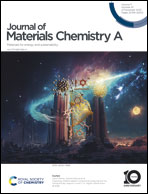The state of Fe3+ in the C–F–A–S–H system with varying Fe/Si and Ca/Si ratios
Abstract
Synthetic CaO–Fe2O3–Al2O3–SiO2–H2O (C–F–A–S–H) gels with Fe/Si and Ca/Si ratios in the ranges 1/8–1/4 and 1.0–2.0, respectively, are investigated to reveal the coordination, location, and doping configuration of Fe3+. The bonding between Fe3+ and Ca2+/Si4+ species is the most favorable, resulting in the transformation from phyllosilicates (i.e., layered C–A–S–H) to network silicates (hydroandradite and disordered gel with a crosslinked structure). The increasing Ca/Si ratio has a critical effect on the evolution of the C–F–A–S–H system, resulting in layered C–(F)–A–S–H because a sufficient concentration of Ca ions is provided. Using Mössbauer spectroscopy, two kinds of octahedral Fe3+ with distinct chemical environments are identified: the distorted one acts as a network modifier, while the highly symmetric one acts as a layered structure former. The former exists in the disordered gel, while the latter mainly exists in the interlayer space of the layered C–(F)–A–S–H. Moreover, Fe3+ is unlikely to enter the tetrahedral position of the aluminosilicate chain in layered C–(F)–A–S–H.



 Please wait while we load your content...
Please wait while we load your content...